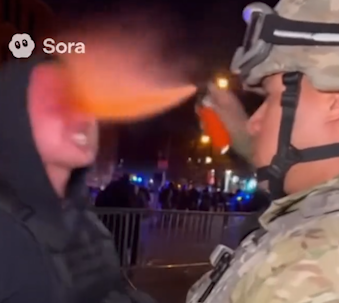
Pepper Spray and Protest: When a Confrontation Turns Explosive
In the midst of heated street demonstrations, a tense exchange between a protester and a soldier quickly spiraled into a dramatic confrontation, now circulating widely on social media. The viral clip captures the exact moment a soldier raises a can of spray and unleashes it directly into the protester’s face after a shouting match escalated beyond control.
The video begins with the protester pressing aggressively toward the soldier, screaming, “What’s your name?” over and over. His voice cuts through the background chaos of flashing lights and distant chants, a symbol of the raw emotion fueling the crowd. Rather than backing down, the soldier stands firm, his expression unreadable beneath his tactical helmet and gear. For a few seconds, the standoff is electric—a clash between civilian defiance and military composure.
But in a split second, the situation changes. The soldier lifts his arm, levels the canister, and unleashes a stream of bright orange spray. The chemical bursts across the protester’s face, forcing him to reel back mid-scream. The crowd reacts audibly, the moment now frozen in countless screenshots and rewinds across platforms like TikTok, Instagram, and X (formerly Twitter).
Reactions to the footage have been polarized. Supporters of the soldier argue that he showed restraint until it became necessary to act. “You can only yell and get in someone’s face so long before there are consequences,” one comment reads. Others, however, condemn the soldier’s use of force, calling it an excessive response to words alone. Civil rights advocates warn that such moments highlight the thin line between maintaining order and abusing power in crowd-control situations.
The spray itself—commonly pepper spray or a similar irritant—is a standard tool in riot control, designed to incapacitate rather than cause lasting harm. Yet, its use remains highly controversial. Victims often suffer burning eyes, difficulty breathing, and disorientation—conditions that, in a chaotic protest environment, can escalate danger rather than reduce it.
This incident also raises questions about authority and accountability. Who decides when shouting crosses the line into a threat? Was the protester’s behavior truly dangerous, or was this an overreaction to verbal pressure? And in a time when every action is instantly recorded and broadcast, does the presence of cameras make soldiers and protesters more likely to escalate rather than de-escalate confrontations?
What is clear is that moments like this don’t just fade into the night—they become symbols. For some, the spray represents strength and discipline against disorder. For others, it epitomizes the imbalance of power between armed forces and unarmed civilians.
As investigations and public debates continue, one thing is certain: in today’s hyper-connected world, a single second of spray can ignite a firestorm of controversy.